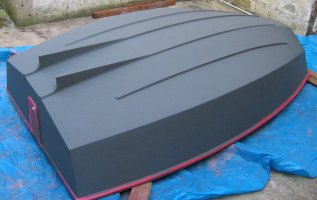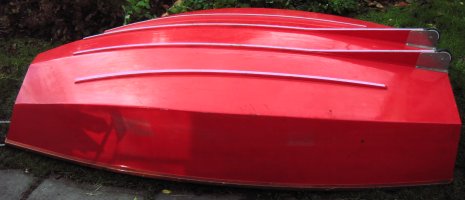
Pram dinghy paint and finish
I used epoxy for the construction and then largely finished the remaining wood work with conventional paints. The exterior of the hull and the interior of the buoyancy tanks were painted and the interior of the boat was varnished. All the painted areas were primed with an aluminium primer and then finished with a yacht enamel under coat and top coat. The only place I used epoxy for the finish was on the underside of the seats. These are the last items to be glued down and finishing them with epoxy saved having to mark out the areas that would not be glued and finish these separately.
I fitted two sets of row lock bearings so the oarsman can change his rowing position. The rowlocks I used are galvanized steel and a bit heavy. I couldn't find any neat bearings so I made up some plates out of stainless steel with a hole to fit the rowlock shaft. These work but are not ideal and are wearing quite quickly. This area could benefit from improvement and it may be work considering thickening up the internal rubbing strake so the rowlocks can be fitted through a sleeved hole or finding some neater rowlocks
The oars are a pair I had left over from another boat and are long enough to allow the boat to be rowed quite easily.
There is a stainless steel U bolt on the front to attach the painter. I sited this just above the top of the seat so the bolts would not allow water to leak into the front buoyancy compartment. This needs to be fairly substantial as the dinghy would be towed using this and it also secures the dinghy on a roof rack. There are cleats either side at the back for mooring and tying down on a car.

The aluminium runners along the keels absorb much of the damage to the bottom of the hull. The stainless steel screws need to be counter sunk below the surface so they can't be caught and pulled out. The aluminium plates supporting the wheels are an extension of the runners so the boat will slide smoothly from the wheels to the runners when going over steps and bumps.

The dinghy is carried on the roof bars of my car. The bars are not long enough to support the boat up side down so I made up some wooden channels that fit over the roof bars and are padded to protect the rubbing strakes. It is quite easy for two people to lift one side of the dinghy onto the roof bars and then slide it across in the channels. I initially made up some ramps that clipped onto the roof bars so the dinghy could be pushed up onto the car single handed. It worked ... but wasn't easy.
| ||||||||||
Links
|
I do not warrant the correctness of this content. The risk from using it lies entirely with the user. While using this site, you agree to have read and accepted the terms of use.
Copyright © 2025. All Rights Reserved. Privacy policy